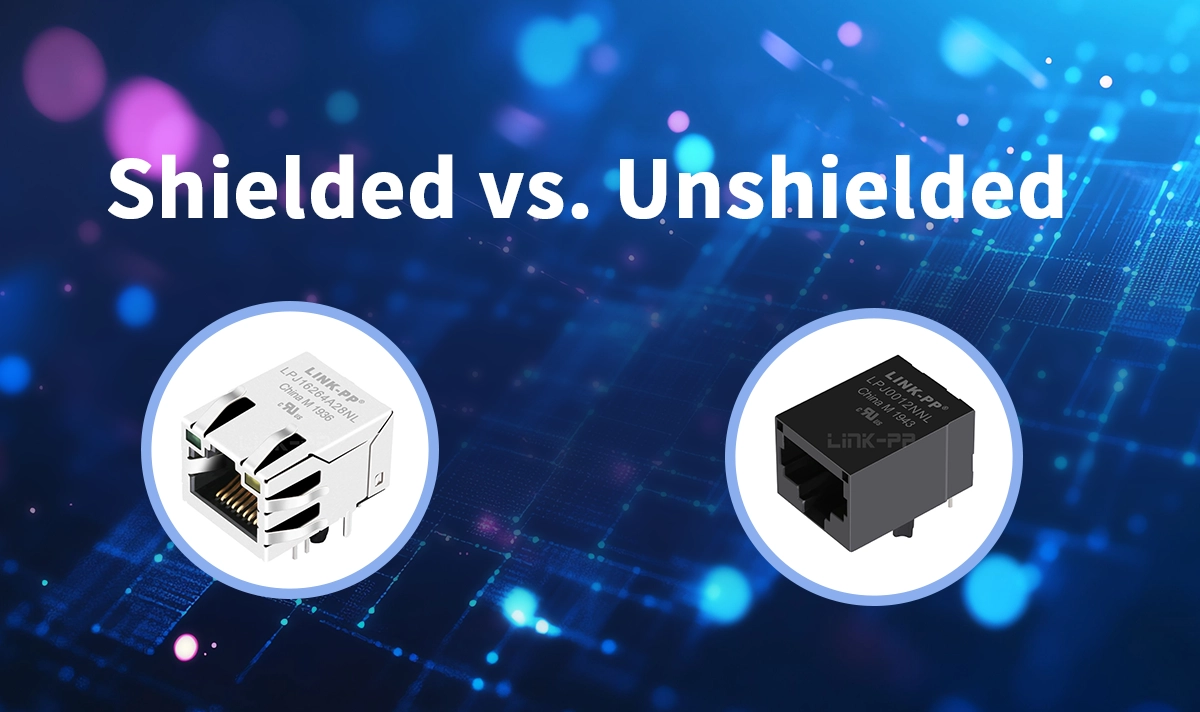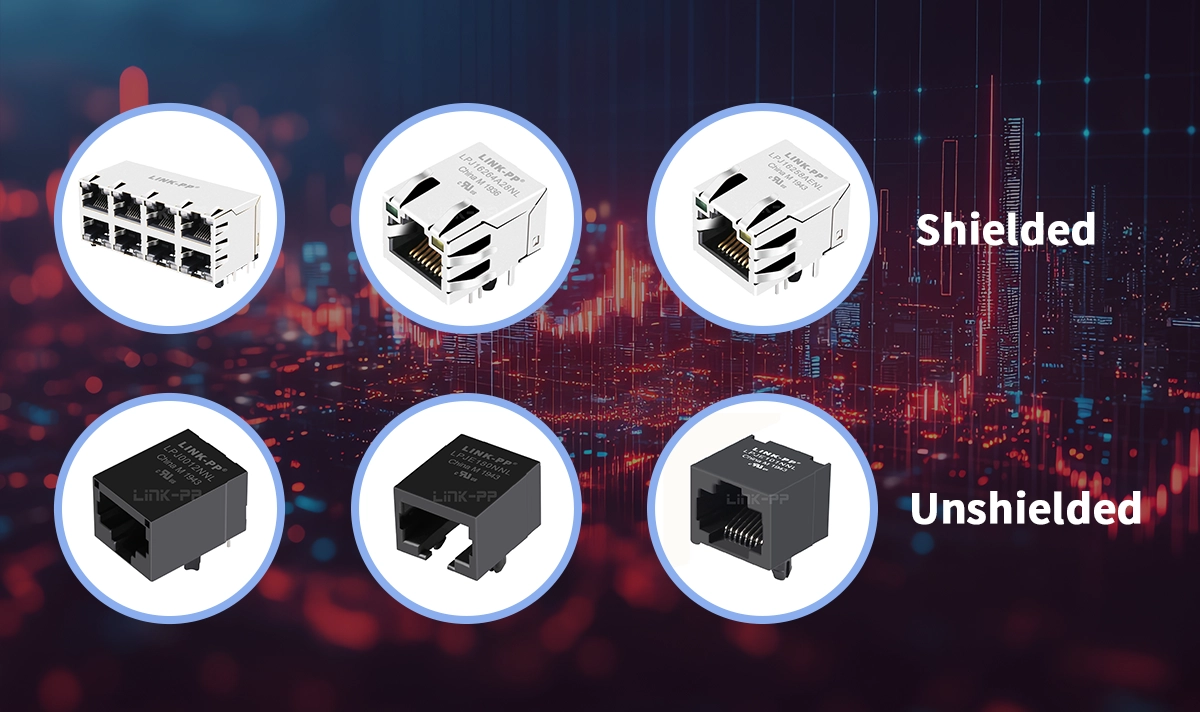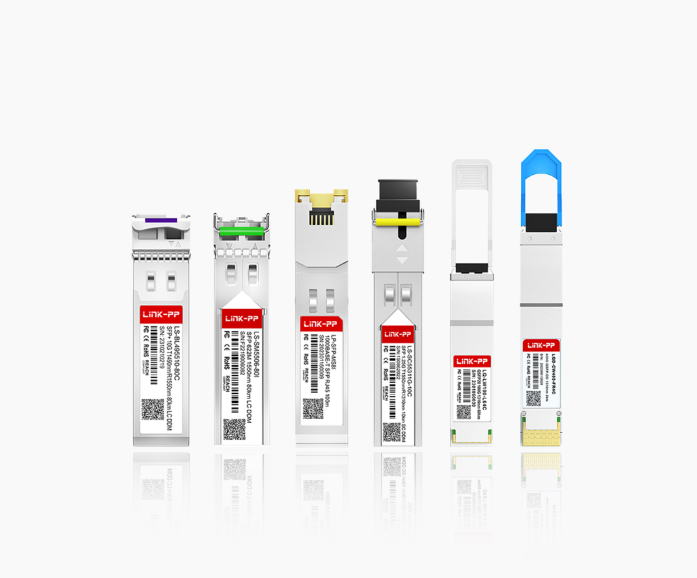
RJ45 connectors are a critical component in Ethernet networking, widely used to connect computers, routers, switches, and other devices. When choosing the right RJ45 connector (this article focuses on PCB-mount RJ45 connectors ) one key decision is whether to use shielded or unshielded versions. This choice affects electromagnetic performance, mechanical design, and the connector's suitability for various application environments..
What Are Shielded RJ45 Connectors?
Shielded RJ45 connectors incorporate a metal shield or grounding shell around the plastic housing of the connector. This shield serves two primary purposes:
Reduce Electromagnetic Interference (EMI) from external sources
Contain Radiated Emissions from within the device
Shielded connectors are typically used with STP/FTP Ethernet cables and must be properly grounded through the PCB or chassis to be effective.
✅ Examples of Shielded RJ45 Jacks:
LPJG47047A4NL – 2x4 Shielded RJ45 Magnetic Jacks Support PoE+
LPJ16264A28NL – 8P8C RJ45 PCB Jack With Shield EMI Tabs
LPJ16258AENL – 10/100 Base-T PoE RJ45 Connector with Integrated Magnetics
What Are Unshielded RJ45 Connectors?
Unshielded RJ45 connectors do not include any metal shield on the outer shell. They are fully enclosed in plastic, making them lighter, easier to install, and more cost-effective. These connectors are typically used with UTP cables in low-interference environments such as home routers, consumer electronics, or office equipment.
Despite lacking shielding, unshielded RJ45 connectors can still include integrated magnetics and LED indicators, enabling them to meet the electrical requirements of Ethernet standards like 10/100/1000Base-T.
✅ Examples of Unshielded RJ45 Jacks:
LPJ0012NNL – 1x1 Port Unshielded RJ45 Jack Tab Down
LPJE180NNL – RJ45 Modular Jack without Magnetics and LED
LPJE101NNL – Compact unshielded 8P8C Jack Tab UP
Key Differences Between Shielded and Unshielded RJ45 Connectors

Feature | Shielded RJ45 Connectors | Unshielded RJ45 Connectors |
|---|---|---|
EMI/RFI Protection | ✅ High | ❌ Low |
External Housing | Metal shielded | Full plastic |
Signal Integrity in Harsh Environments | Excellent | Basic |
Cost | Higher | Lower |
Typical Cable Type | STP / FTP | UTP |
Grounding Required | Yes | No |
Use Case | Industrial, PoE switches, medical, telecom | Home gateways, printers, consumer electronics |
How to Choose Between Shielded and Unshielded RJ45
When selecting an RJ45 connector for your PCB, consider the following:
✅ Choose Shielded RJ45 when:
Device is used in EMI-sensitive environments (factories, data centers, power systems)
You are designing for Power over Ethernet (PoE/PoE+)
The product will be installed near high-frequency equipment
✅ Choose Unshielded RJ45 Modular Jack when:
Cost optimization is a priority
The environment is low in EMI/RFI
Ease of assembly and simplified PCB layout is desired
Application Scenarios
Industry | Recommended Type | Reason |
|---|---|---|
Industrial Automation | Shielded | Strong EMI resistance needed |
Consumer Electronics | Unshielded | Lightweight, cost-effective |
Telecom / PoE Switches | Shielded | Power and signal stability |
Office Networking | Unshielded | Quiet EMI environment |
Medical Devices | Shielded | Signal integrity is critical |
Conclusion
Both shielded and unshielded RJ45 connectors have their roles in modern Ethernet networking. The decision depends on EMI environment, device application, cost constraints, and assembly design. When building reliable, standards-compliant Ethernet ports into your hardware, be sure to match the connector’s shielding level with your real-world application requirements.
Whether you're designing a compact consumer device or an industrial-grade switch, the right RJ45 connector is a critical choice for long-term performance and compliance.
🔎 Frequently Asked Questions (FAQ)
Q1: Can an unshielded RJ45 connector include magnetics and LEDs?
A: Yes. Unshielded RJ45 connectors can fully integrate magnetics (such as isolation transformers and common-mode chokes) and LED indicators. The absence of shielding only affects EMI performance, not functionality.
Q2: Is shielding required for Ethernet compliance?
A: No. Ethernet standards like IEEE 802.3 do not mandate shielding. However, shielding is recommended in high-EMI environments to maintain signal integrity and reduce emissions.
Q3: Will using a shielded RJ45 with unshielded cable cause problems?
A: It may reduce the effectiveness of the shield. For optimal EMI performance, the connector and cable should both be shielded and properly grounded.
Q4: Do shielded RJ45 connectors require a PCB ground connection?
A: Yes. The metal shell of a shielded RJ45 must be electrically connected to the PCB ground plane or chassis to provide EMI protection. Without grounding, the shield is ineffective.
Q5: What are the signs that I need a shielded RJ45 instead of unshielded?
A: Consider a shielded RJ45 if:
Your product operates in environments with motors, RF transmitters, or power supplies
You’ve experienced EMI-related performance issues
Your device needs to meet stringent EMC (Electromagnetic Compatibility) regulations
Q6: How do I identify if a connector is shielded or unshielded?
A: Visual inspection can help:
Shielded RJ45s have a metal shell around the port, often silver in color, and may include grounding tabs.
Unshielded RJ45s are typically all-plastic and do not have any metal shell.




